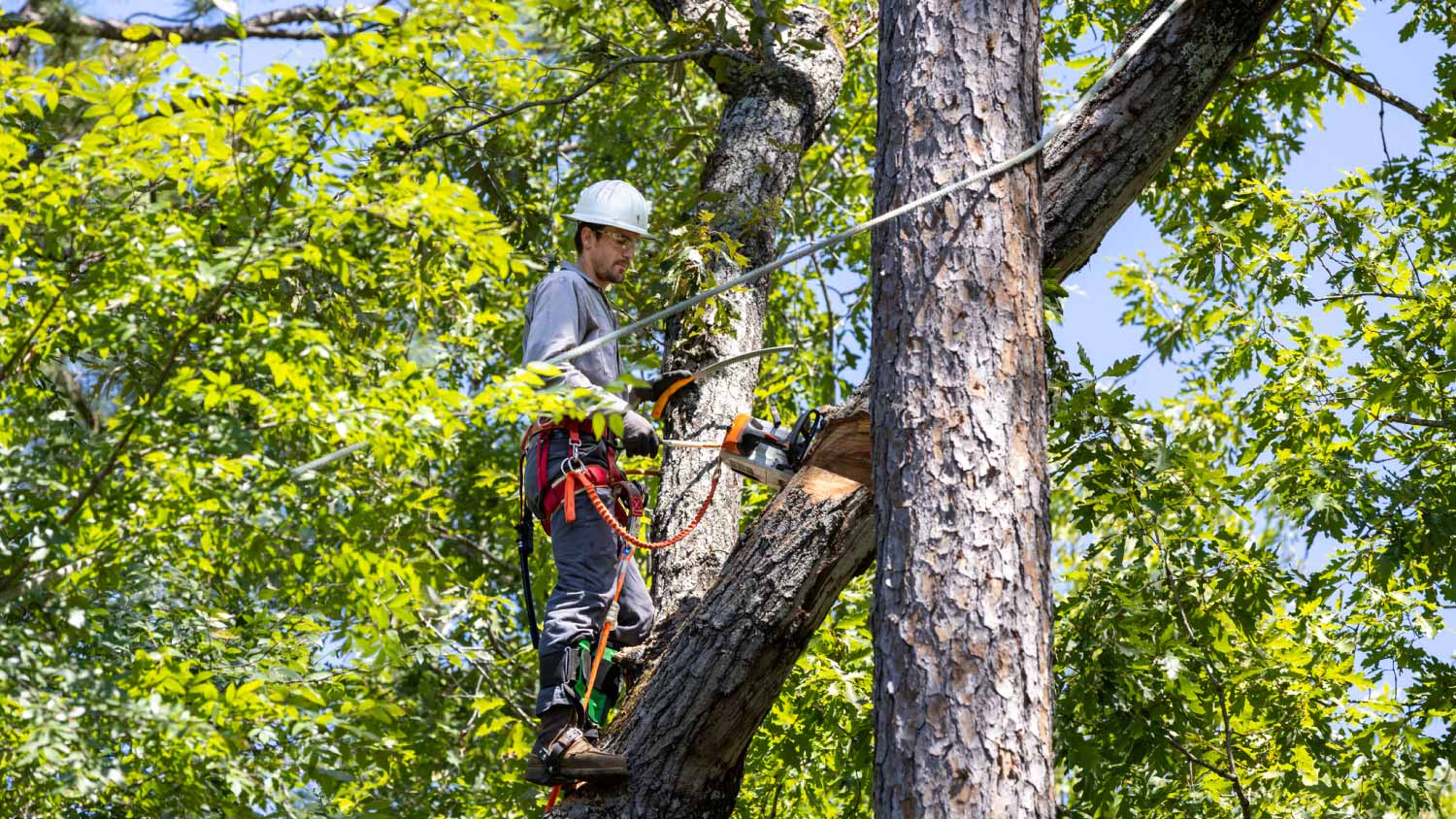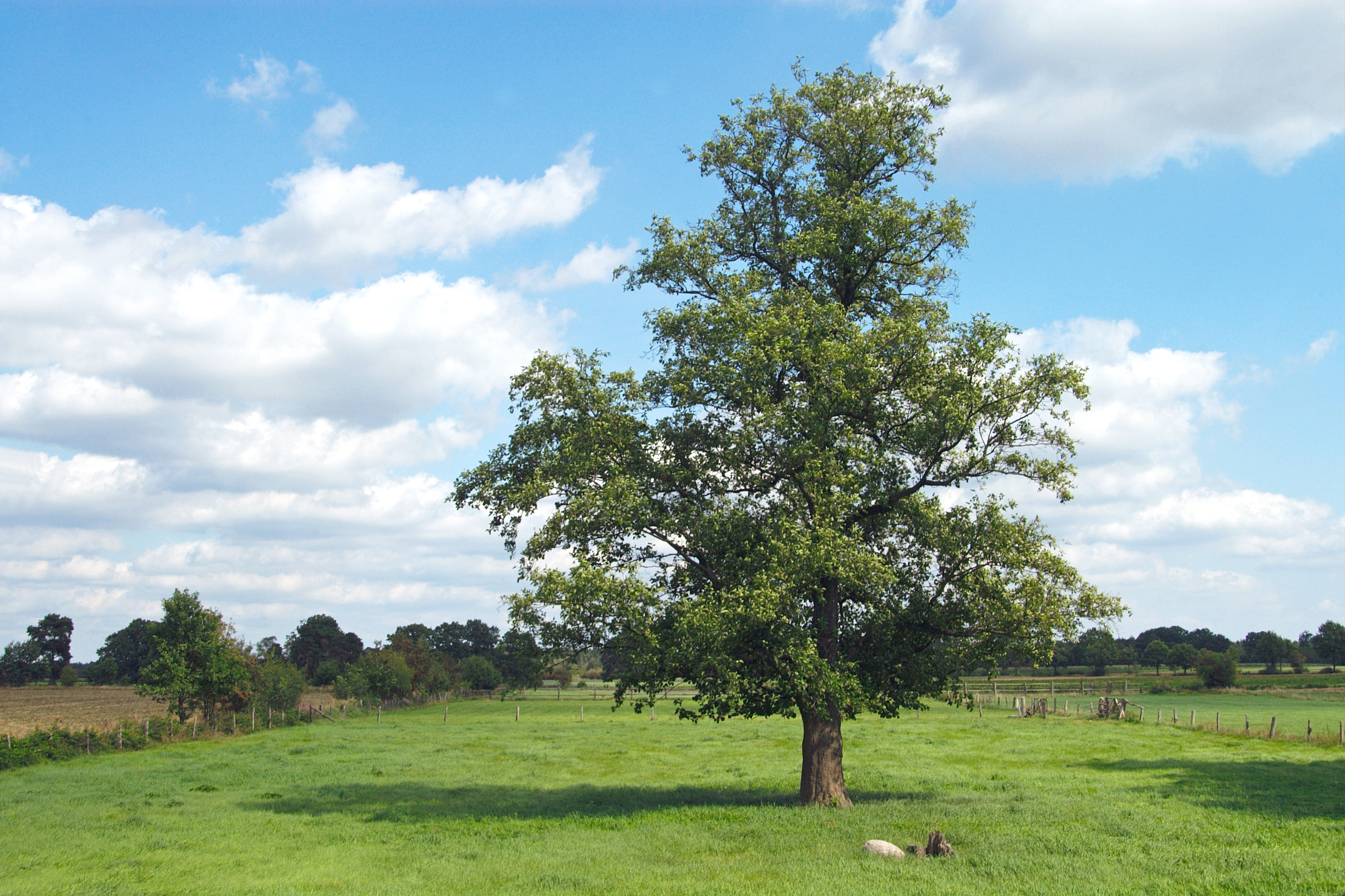
Discover what the current average tree removal cost is based on different factors to know how much it will cost to take care of a dead or troublesome tree on your property.
Both you and your trees are trying to put down some roots—here's how to work together


Tree roots can cause pavers to shift and crack over time.
Pavers are still the most cost-effective patio and walkway options to place near trees.
You can avoid tree root damage with a few precautionary steps.
Speak with a professional tree service if tree removal is the only option.
As much as we'd love our backyard ecosystem to work in perfect harmony, tree roots pose a real threat to patio, walkway, and driveway pavers, causing unsightly cracks, inconsistencies, and tripping hazards. It takes some effort to stop tree roots from lifting your pavers. Let's explore what you can do about pavers and tree root damage and how to prevent extreme damage with the help of a tree maintenance professional.
A tree's expanding root zone can interfere with your pavers, whether the tree is old or a few years old. Surface-level tree roots can reach the pavers themselves, or large tree roots deep in the earth can shift the ground under your patio and cause pavers to rise, sink, or crack.
However, even though these backyard regulars are longtime foes, patio pavers are still one of the best options when installing a hardscape near trees. Pavers are easier to replace or repair individually if tree roots damage them. Cracked or uneven concrete slabs, on the other hand, could lead to much more significant and costly repairs.
Large concrete patio repairs cost between $5 and $20 per square foot. Paver repairs, however, are much easier to DIY and can cost as little as $0.50 per paver, depending on the material.

Protecting your pavers from tree roots comes down to where you are in your project. If you're just about to install a paver patio, you can work with the current root system in your yard. Several options exist to mitigate damage if the patio already exists and is butting up against root issues.
First things first: Place your pavers between three and six feet away from a mature tree whenever possible. Every tree species has an individual root zone—or how far the roots extend as they age. If you don't have mature trees with large tree roots now, remember that you intend to keep your patio there for years, if not decades, so it could be an issue down the line.
Assume the tree’s root zone spreads 1½ feet in diameter for every inch of the tree's trunk. However, trees and their root patterns differ, so speak with a local tree maintenance expert for complete details.
Before laying pavers, cut and remove all roots beneath your patio or walkway area, known as root pruning. Even if the roots no longer connect to your tree, pull them out of the ground entirely. If not, they'll eventually decompose and leave holes beneath your patio.
Depending on the size of the root, you may be able to dig around it and cut it out with pruning shears or a durable handsaw. Target only larger roots close to the surface that have a good chance of causing problems in the future, and replace soil carefully when finished.
This process is no small task, so you may want to call in the help of a local top-rated tree maintenance pro. We also recommend getting advice from your arborist to avoid doing significant harm to the tree's health so you can protect your tree during construction. A tree can often survive the removal of some roots, but removing too many can damage one side of the tree or threaten its survival.
Digging a 7- to 8-inch trench around your pavers can help keep your patio or walkway level, whether it’s for a new or existing patio. Re-dig the trench once a year to remove any invading roots and to discourage the tree from continuing in this direction.
If you live in what feels like a fairy-tale forest of old elms and oaks, a concrete footer may be your best bet against inevitable wandering tree roots. While all pavers lay in several inches of sand, a concrete barrier provides solid protection against long-term root damage.
Let's say you've caught the root-paver issue early, but you already have an installed patio. Removing individual surface-level roots is one of the most common solutions to paver problems. Delicately pry up the affected pavers with a flat-head screwdriver, remove the polymeric sand, and set both aside. Remove small tree roots by hand and rent a stump grinder. Renting a stump grinder costs about $190 for larger roots.
If you have a chance to choose what tree to plant near pavers, you may be able to reduce problems early by choosing the right species. Different trees have different root systems; some are more notorious for pushing above ground than others.
To keep root problems to a minimum, look for trees with mild root systems like dogwoods, crabapples, myrtle trees, Japanese maples, and magnolias. Silver maples are popular and are more notorious for shooting up surface-level roots. Be careful: Trees like walnuts and white oaks are also known for noninvasive root systems, but they can grow very large over time and aren’t the best choices near pavers.
Lawn aerating is a process that uses a core aerator or similar tool to remove some soil plugs from the ground and loosen nearby soil. You may have heard of aeration as a tool to help keep lawns healthy, but it plays another important role.
When soil is pushed down by the weight of heavy equipment or tamping machines, it can cause soil compaction. Soil compaction is bad news for tree roots: It may damage them and make the soil so thick that roots have trouble growing. That makes it more likely for tree roots to push to the surface, causing paver problems. Aeration can alleviate that issue.
Here’s where we run into a problem: Many paver projects suggest tamping down the soil and leveling it, which sounds like the opposite of aeration and could lead to compaction. We suggest aerating the surrounding soil first, then using tamping and leveling methods sparingly to keep the soil beneath as root-friendly as possible. Adding a layer of gravel or sand makes it easier to level the surface for pavers without causing soil compaction.
To limit root damage, you can also choose flexible pavers. This type of paver is made of rubber or recycled plastic materials, like the Flexgard Tru-Pave brand, and can handle shifts in the soil more easily without cracking. These interlocking tiles are available in several shades and designs.
Flexible pavers can’t prevent root problems. But they can minimize damage, and reduce noticeable impact until you can cut the roots or find other solutions. An offshoot of flexible pavers are permeable pavers, which are made from durable, waterproof materials and designs that allow water to soak through pavers and into the soil easily. That may sound strange, but it helps combat surface-level root growth by making it easier for tree roots to access all the water they need at deeper levels.
The healthier the tree, the less likely it will create those tangled, surface-level roots that cause many paver problems. Treat your tree well with steps like:
When first planting trees around pavers, loosen up the root ball and gently spread roots out as much as possible before planting. Plants with tightly-bundled or overgrown root balls are much more likely to have surface root issues.
Keep the tree well-watered, especially as it is growing. Thirsty trees are more likely to send roots out into unusual places.
When pruning roots or branches, keep your cuts as straight and “clean” as possible.
Watch for diseases like fungal infections, or an attack of hungry bugs.
Keep your trees carefully pruned to encourage healthy growth, and discourage leaves and stains on your pavers. Avoid “topping” decorative paver-based trees.
In the most extreme scenario, you may find that removing a tree and as much of its root system as possible is the best option for your landscape. For example, this may be the case if a tree sits in the only area where you could have a patio or if roots are keeping you from creating an accessible walkway.
Also, large tree roots can damage foundations and cause drainage issues over time, so be sure to look at the big picture when making this choice. Keep in mind that some states require specific permits to remove trees, so we always recommend calling a local tree removal service to assess how and when to remove a tree.
You'll find plenty of landscapers and general contractors with hardscape experience, but it's important to find a paver specialist who understands tree root issues. The best local paver specialists are also insured and bonded, offer guarantees on their work, and are often members of the Interlocking Concrete Pavement Institute (ICPI).
We also recommend shopping around and requesting at least three estimates for major repairs. If the project calls for it, many paver experts will also have links to trusted tree removal and stump grinding services.
I had Ace Fireplace Services install custom chimney caps for my home, and the results are stunning. They fit like a glove and have added a touch of sophistication to my chimney. I can't recommend their services enough.
Great tree company, very professional and honest. Glad we found them, they had the best pricing
Maple Tree Service should serve as a mentor for other business! Customer service was superior and beyond expectation. Response to request was prompt. The representative was very courteous and proud of the company. Quote was given during initial visit and work date established. A follow up...
We used Unique Hardwood Floor LLC three years ago to work on the floors of a 70 year old home that needed a great deal of work. Some floors needed repairs, some were replaced and others just needed to be refinished. It was a complicated job as they needed to blend the old and the new to...
I play a yearly service fee to get my heat and AC checked out, twice a year. It's awesome. The techs are always great.
Very good service. Will use them again in the future.
The team (Kai and Co.) that handled our move was great! Great attitudes; great service; great care. Please reconsider your policy of no moves to AZ. Weâ??d love to use you again in a few months!
Best service I've received. Prompt, friendly, informative and trusting. Highly recommend.
Amazing. Very professional service and a thorough and well job done.
From average costs to expert advice, get all the answers you need to get your job done.

Discover what the current average tree removal cost is based on different factors to know how much it will cost to take care of a dead or troublesome tree on your property.

Find out how much it costs to plant a tree based on the number of trees, their size, where you want to plant them, and DIY versus professional costs.

Tree inspections can ensure your trees stay healthy and safe, preventing costly damage. Learn how much tree inspections cost and what can affect the price.

Will a topped tree grow back? It’s possible, although this aggressive pruning can sometimes kill a tree. Here’s what you need to know about tree topping.

What is an arborist and do they cut down trees? Learn what an arborist is, the services they offer, and when to hire one.

What is a field elm vs. Siberian elm? Learn the distinguishing traits of each tree to help you identify which one is in your yard.